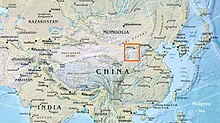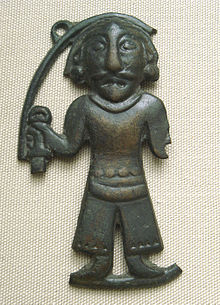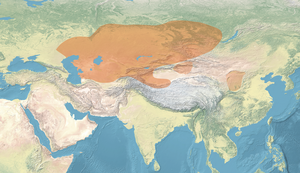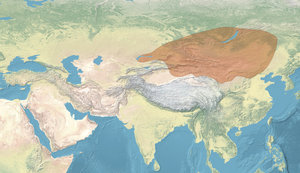Ordos culture
 | |
| Geographical range | Ordos Plateau |
|---|---|
| Period | lateNeolithicto earlyBronze Age |
| Dates | c. 800–150 BCE[1] |
| Preceded by | Zhukaigou culture Shimao culture Siwa culture Xicha culture |
| Followed by | Han dynasty |

TheOrdos culture(simplified Chinese:Ngạc ngươi nhiều văn nhã hóa;traditional Chinese:Ngạc ngươi nhiều văn nhã hóa) was a material culture occupying a region centered on theOrdos Loop(corresponding to the region ofSuiyuan,includingBaotouto the north, all located in modernInner Mongolia,China)[3]during theBronzeand earlyIron Agefrom c. 800 BCE to 150 BCE.[4]The Ordos culture is known for significant finds ofScythian artand may represent the easternmost extension ofIndo-EuropeanEurasian nomads,such as theSaka,[5][6][7]or may be linkable toPalaeo-SiberiansorYeniseians.[8]Under theQinandHandynasties, the area came under the control of contemporaneous Chinese states.
Background[edit]
The Ordos Plateau was covered by grass, bushes, and trees and was sufficiently watered by numerous rivers and streams to produce rich grazing lands.[9]At the time, it contained the best pasture lands on theAsian Steppe.[10]
Equestrian nomads from the north-west occupied the area previously settled by theZhukaigou cultureand theShimao culturefrom the 6th to the 2nd century BCE before being driven away by theXiongnu.[11]Some authors date the arrival from the north and west of these nomads practicing mounted warfare to the 4th century BC, corresponding roughly to the period of the conquests ofAlexander the GreatinCentral Asia.[12]They came in several waves from Central Asia and Southern Siberia through theGansu corridorbefore settling in the Ordos region.[13]They may have interacted with theYuezhi[14]in the process.[13]
This also roughly corresponds to the period when mounted warfare was introduced in the Chinese state ofZhao,during theWarring States period,by groups called by the ChineseHu( hồ, "Nomads" ) orDonghu( Đông Hồ "Eastern Nomads" ) and theLinhu( lâm hồ "Forest Nomads" ),[15][16][17]who stimulated the interest of the Zhao king with their "archery from horseback"( cưỡi ngựa bắn cungqíshé).[13]Sometimes, Chinese sources clearly differentiated theHuand theXiongnu,who consolidated their eastern empire by the end of the 3rd century BC.[13]yet on other occasions Chinese sources often just classified the Xiongnu as aHupeople,which was a blanket term fornomadic people.[18][19]
Early characteristics[edit]
The Ordos are mainly known from their skeletal remains and artifacts. The Ordos culture of about 500 BCE to 100 CE is known for its "Ordos bronzes", blade weapons,finialsfor tent-poles, horse gear, and small plaques and fittings for clothes and horse harness, usinganimal styledecoration with relationships both with theScythian artof regions much further west, and alsoChinese art.Its relationship with the Xiongnu is controversial; for some scholars they are the same and for others different.[20]Many buried metal artefacts have emerged on the surface of the land as a result of the progressivedesertificationof the region.[21]

The Ordos are thought to be the easternmost of theIranian peoplesof theEurasian Steppe,just to the east of the better-knownYuezhi,also anIndo-European-speaking people.[6][7]Because the people represented in archaeological finds tend to displayEuropoidfeatures, also earlier noted byOtto J. Maenchen-Helfen,[22]Iaroslav Lebedynskysuggests the Ordos culture had "a Scythian affinity".[23][24]Other scholars have associated it with the Yuezhi[9]or thePalaeo-Siberians(specifically,Yeniseians).[25]The weapons found in tombs throughout the steppes of the Ordos are very close to those of theScythiansandSaka.[9][26]The Ordos culture has strong similarities with theShajing cultureinGansuto the west, theSakaculture of theXin gian g,and theUpper Xiajiadian cultureofLiaoningto the northeast.[27]
Recent archeological and genetic data suggests that the Western and Eastern Scythians of the 1st millennium BC originated independently, but both combineYamnaya-related ancestry, which spread eastwards from the area of the European steppes, with anEast Asian-related component, which most closely corresponds to the modern NorthSiberianNganasan peopleof the lowerYenisey River,to varying degrees, but generally higher among Eastern Scythians.[28]
On the other hand, archaeological evidence now tends to suggest that the origins ofScythian culture,characterized by itskurgansburial mounds and itsAnimal styleof the 1st millennium BC, are to be found among Eastern Scythians rather than their Western counterparts: eastern Scythiankurgans(such as the Altaic kurganArzhan 1inTuva) are older than western Scythian kurgans, and elements of theAnimal styleare first attested in areas of theYenisei riverand modern-day China in the 10th century BC.[29]The rapid spread of Scythian culture, from the Eastern Scythians to the Western Scythians, is also confirmed by significant east-to-west gene flow across the steppes during the 1st millennium BC.[28][29]
TheMaoqinggouculture at the eastern edge of the Ordos area is also considered as a "Scythian culture", which ultimately disappeared in the 3rd-2nd centuries BCE with the onset of theXiongnu.[30]Their culture expanded tremendously, and in the northeast of China replaced earlier cultures such as theUpper Xiajiadian.[31]
Early bronze artifacts (6-5th century BC)[edit]
Several Ordos artifacts from the 6-5th century BC reflect a nomadic culture based on the chariot rather than the mounted horse. These include chariot ornaments for chariot yokes, which have been excavated in nomadic tombs.[37]
The material used was bronze, in contrast to the silver and gold which appeared from the 4th century BC, together with the mounted-horse culture.[37]Chariot ornaments disappeared from graves around that time.[37]The artifacts were probably created in the foundries of the pre-DynasticState of Qinfor the nomadic herders of the Ordos.[37]
Introduction of new metallurgy and style (4th-3rd century BC)[edit]
Around the 4th century BC, grave goods starting to change markedly.[12]The chariot, which had been a central funerary artifact among nomadic people, was replaced by the horse. The iconography of grave artifacts became clearly derived fromAltaicor Northern Asian motifs.[12]The new iconography of this period, combined with the fact that it first appears in southernNingxiaand southeasternGansuto the west of the Ordos, suggests that these horse-mounted nomads came from Northern Asia and southernSiberiathrough Gansu, probably in several waves.[37]
Gold and silver replaced tinned bronze.[12]AGold stag with eagle's headfound at the southern edge of the Ordos desert exemplifies the new "intrusive style" introduced by the Ordos nomads.[12]The motif of the "raptor-headed creature" is earlier documented from thePazyryk culture,and is part of a Eurasian symbolic system known from around the 7th century BC and identified inSakaburial sites.[13]Anomadic gold crownwas also excavated in the Ordos, and dated to the 3rd century BC.[13]New techniques such asgranulationwere also introduced from the west across Eurasia and would then be adopted by China.[13]
These artifacts, such as those depicting raptor-headed mythological creatures, are often attributed to theXiongnu,but this is an impossibility since the Xiongnu were not yet in the region in the 4th century BCE and could not have imported these designs to northwestern China, and furthermore these styles actually disappeared soon after the arrival of the Xiongnu.[38]They should instead be attributed to the pre-Xiongnu nomads would occupied the Ordos at that time, including possibly theYuezhi.[38]
-
Gold stag with eagle's head, characteristic of the new style introduced by the Ordos nomads. Excavated at the southern border of the Ordos desert.[12]
-
Nomadic gold crown excavated in the Ordos, 3rd century BC[13]
-
Gold belt buckle in Scythian style, fromXigoupanM2 (4th–3rd c. BCE)
Contact with neighbouring peoples[edit]

While theethnolinguisticorigins and character of the Ordos culture are unknown, the population appears to have been significantly influenced byIndo-European cultures.[6]However, the art of the Ordos culture appears to have similarities to that of theDonghu people(Chinese:Đông Hồ), aMongolic-speaking nomadic tribe located to the east, suggesting that the two had close ties.[39]
The Ordos population was also in contact – and reportedly often at war – with thepre-Hanand Han peoples. The Ordos culture covered, geographically, regions later occupied by the Han, including areas just north of the laterGreat Wall of Chinaand straddling the northernmost hook of theYellow River.
To the west of the Ordos culture was another Indo-European people, theYuezhi,although nothing is known of relations between the two. (The Yuezhi were later vanquished by the Xiongnu andWusun,who reportedly drove them westward, out of China; a subgroup of the Yuezhi is widely believed to have migrated toSouth Central Asia,where it constituted the ruling elite of theKushan Empire.)
Arrival of the Xiongnu (circa 160 BC)[edit]
TheXiongnu's early appearance was recorded north ofWild Goose GateandDaicommanderies before 265 BCE, just before theZhao-Xiongnu War;[43][44]however,sinologistEdwin Pulleyblank(1994) contends that pre-241-BCE references to the Xiongnu are anachronistic substitutions for theHu peopleinstead.[45][46]They are also mentioned in Chinese sources, official ones likeRecords of the Grand Historian,[47]and unofficial ones likeYi Zhou Shu[48]andClassic of Mountains and Seas[49]as having occupied theOrdos plateauduring theWarring States periodbefore it was occupied by the states ofQinandZhao.[50]It is generally thought to be their homeland; however, when exactly they came to occupy the region is unclear and archaeological finds suggest it might have been much earlier than traditionally thought.[51]The Xiongnu regained their homeland up to China's borders, more than ten years after their expulsion, during the post-Qin chaos when Meng Tian had died and convicts stationed to guard the borders returned home.[52]
As the Xiongnu expanded southward into Yuezhi territory around 160 BCE under Modun, the Yuezhi in turn defeated the Sakas and pushed them away atIssyk Kul.It is thought the Xiongnu also occupied the Ordos area during the same period, when they came in direct contact with the Chinese. From there, the Xiongnu conducted numerous devastating raids into Chinese territory (167, 158, 142, 129 BCE).[53]
TheHan–Xiongnu Warbegan withEmperor Gaozu of Han,and the Han colonized the area of the Ordos as the commandery ofShuofangin 127 BCE. Prior to this campaign, there were already earlier commanderies established by Qin and Zhao before they were overrun by the Xiongnu in 209 BCE.[54]
Xiongnu period artifacts[edit]
Belt plaques in the shape of a kneeling horse in gilded silver, were made in North China for Xiongnu patrons in 3rd-1st century BCE.[55][56]Belt buckles with animal combat scenes were made in the 2nd-1st century BCE, mainly by North China workshops for the Xiongnu. These plates were inspired by the art of the steppes, but the design was flattened and compressed within the frame.[57][56]
-
Belt buckle with paired felines attacking ibexes, derived from earlierScythian art.Ordos, 3rd century BC. Usually described asXiongnudespite early date.[58][59][60]
-
Belt plaque with design of wrestling men, Ordos region and western part of North China, 2nd century BC, bronze - Ethnological Museum, Berlin[61]
-
Horse attacked by tiger, Ordos, 4th-1st century BCE[62]
References[edit]
Citations[edit]
- ^Honeychurch, William (2015).Inner Asia and the Spatial Politics of Empire: Archaeology, Mobility, and Culture Contact(PDF).p. 112.doi:10.1007/978-1-4939-1815-7.ISBN978-1-4939-1814-0.
- ^Maenchen-Helfen, Otto; Helfen, Otto (1 January 1973).The World of the Huns: Studies in Their History and Culture.University of California Press. p. 371.ISBN978-0-520-01596-8.
- ^The Silk Road Encyclopedia.Seoul Selection. 18 July 2016. p. 1959.ISBN978-1-62412-076-3.
- ^Honeychurch, William (2015).Inner Asia and the Spatial Politics of Empire: Archaeology, Mobility, and Culture Contact(PDF).p. 112.doi:10.1007/978-1-4939-1815-7.ISBN978-1-4939-1814-0.
- ^Lebedynsky 2007,p. 131
- ^abcMacmillan Education 2016,p. 369 "From that time until the HAN dynasty the Ordos steppe was the home of semi-nomadic Indo-European peoples whose culture can be regarded as an eastern province of a vast Eurasian continuum of Scytho-Siberian cultures."
- ^abHarmatta 1992,p. 348: "From the first millennium b.c., we have abundant historical, archaeological and linguistic sources for the location of the territory inhabited by the Iranian peoples. In this period the territory of the northern Iranians, they being equestrian nomads, extended over the whole zone of the steppes and the wooded steppes and even the semi-deserts from the Great Hungarian Plain to the Ordos in northern China."
- ^"The genetic and linguistic evidence for the xiongnu-yenisseian hypothesis".ResearchGate.Retrieved1 February2022.
- ^abcHanks & Linduff 2009,pp. 284–286
- ^Beckwith 2009,p. 71
- ^Bunker 2002,pp. 26–29
- ^abcdefBunker 2002,p. 26
- ^abcdefghiBunker 2002,pp. 27–28
- ^Thierry 2005.
- ^Shiji"Hereditary House of Zhao"quote: "Nay trung sơn ở ta tim gan, bắc có yến, đông cóHồ,Tây cóLâm hồ,Lâu phiền, Tần, Hàn chi biên, mà vô cường binh chi cứu, là vong xã tắc, nại gì? "translation:" NowZhongshanis at our heart and belly [note: Zhao surrounded Zhongshan, except on the Zhongshan's north-eastern side],Yanto the north,Huto the east,Forest Huto the west,Loufan,Qin,Hanat our borders. Yet we have no strong army to help us, surely we will lose the country. What is to be done? "
- ^Stratagems of the Warring States,"King Wuling spends his day in idleness", quote: "Tự thường sơn cứ thế đại, thượng đảng, đông có yến,Đông HồChi cảnh, tây có lâu phiền, Tần, Hàn chi biên, mà vô cưỡi ngựa bắn cung chi bị. "Jennifer Dodgson's translation:"FromMount ChangtoDaiandShangdang,our lands border Yan and theDonghuin the east, and to the west we have the Loufan and shared borders with Qin and Han. Nevertheless, we have no mounted archers ready for action. "
- ^Pulleyblank 1994,p. 518.
- ^Di Cosmo, Nicola. 2002.Ancient China and its Enemies: The Rise of Nomadic Power in East Asian History.Cambridge University Press. p. 129.
- ^Pulleyblank 1994,p. 519-520.
- ^Comparethisandthisaccount, both from the 1970s. Bunker, 200, sees them as the same, or rather the Ordos people as a subgroup of the Xiongnu.
- ^Bunker 2002,p. 200
- ^Maenchen-Helfen 1973,pp. 369–375
- ^Lebedynsky 2007,p. 125 "Europoid faces in some depictions of the Ordos, which should be attributed to a Scythian affinity"
- ^Lebedynsky 2007,p. 125 "The Mongoloid types of the Transbaikal area and Central and Eastern Mongolia are strongly contrasted with the Europoid type displayed at the same time by the Scythian nomads occupying Western Mongolia and their predecessors of the Bronze age."
- ^"The genetic and linguistic evidence for the xiongnu-yenisseian hypothesis".ResearchGate.Retrieved1 February2022.
- ^Lebedynsky 2007,p. 127
- ^Cosmo, Nicola Di (1999).Northern Frontier in Pre-Imperial China (Cambridge History of Ancient China).Cambridge University Press. pp. 951–952.
The Saka culture in Xin gian g, the Shajing culture in Gansu, the Ordos complex in Inner Mongolia, and the Upper Xiajiadian culture of Liaoning, all point to a transition from mixed agropastoral to predominantly or exclusively pastoral nomadic cultures. From the seventh century onwards, objects related to improved horse management and horse riding, such as the bit, cheekpieces, horse masks, and bell ornaments, became ever more widespread and sophisticated.
- ^abUnterländer, Martina; Palstra, Friso; Lazaridis, Iosif; Pilipenko, Aleksandr; Hofmanová, Zuzana; Groß, Melanie; Sell, Christian; Blöcher, Jens; Kirsanow, Karola; Rohland, Nadin; Rieger, Benjamin (3 March 2017)."Ancestry and demography and descendants of Iron Age nomads of the Eurasian Steppe".Nature Communications.8:14615.Bibcode:2017NatCo...814615U.doi:10.1038/ncomms14615.ISSN2041-1723.PMC5337992.PMID28256537.
"Genomic inference reveals that Scythians in the east and the west of the steppe zone can best be described as a mixture of Yamnaya-related ancestry and an East Asian component. Demographic modelling suggests independent origins for eastern and western groups with ongoing gene-flow between them, plausibly explaining the striking uniformity of their material culture. We also find evidence that significant gene-flow from east to west Eurasia must have occurred early during the Iron Age." and "The blend of EHG [European hunter-gatherer] and Caucasian elements in carriers of the Yamnaya culture was formed on the European steppe and exported into Central Asia and Siberia". We therefore considered an alternative model in which we treat them as a mix of Yamnaya and the Han (Supplementary Table 25). This model fits all of the Iron Age Scythian groups, consistent with these groups having ancestry related to East Asians not found in the other populations. Alternatively, the Iron Age Scythian groups can also be modelled as a mix of Yamnaya and the north Siberian Nganasan (Supplementary Note 2, Supplementary Table 26).
- ^abUnterländer, Martina; Palstra, Friso; Lazaridis, Iosif; Pilipenko, Aleksandr; Hofmanová, Zuzana; Groß, Melanie; Sell, Christian; Blöcher, Jens; Kirsanow, Karola; Rohland, Nadin; Rieger, Benjamin (3 March 2017)."Ancestry and demography and descendants of Iron Age nomads of the Eurasian Steppe".Nature Communications.8:14615.Bibcode:2017NatCo...814615U.doi:10.1038/ncomms14615.ISSN2041-1723.PMC5337992.PMID28256537.
The origin of the widespread Scythian culture has long been debated in Eurasian archaeology. The northern Black Sea steppe was originally considered the homeland and centre of the Scythians until Terenozhkin formulated the hypothesis of a Central Asian origin. On the other hand, evidence supporting an east Eurasian origin includes the kurgan Arzhan 1 in Tuva, which is considered the earliest Scythian kurgan. Dating of additional burial sites situated in east and west Eurasia confirmed eastern kurgans as older than their western counterparts. Additionally, elements of the characteristic 'Animal Style' dated to the tenth century BCE were found in the region of the Yenisei river and modern-day China, supporting the early presence of Scythian culture in the East.
- ^Pankova, Svetlana; Simpson, St John (21 January 2021).Masters of the Steppe: The Impact of the Scythians and Later Nomad Societies of Eurasia: Proceedings of a conference held at the British Museum, 27-29 October 2017.Archaeopress Publishing Ltd. p. 523.ISBN978-1-78969-648-6.
In the eastern end of the Scythian world in northern China, in the area ofLake Daihaito the northwest of Ordos,there is a Scythian culture known as Maoqinggou.
- ^Di Cosmo, Nicola (2008).The Cambridge History of Ancient China From the Origins of Civilization to 221 BC. Chapter 13THE NORTHERN FRONTIER IN PRE-IMPERIAL CHINA.Cambridge University Press. pp. 885–966.
BRONZE PRODUCTION. Bronze objects from Scythian sites in northern China comprise fairly typical nomadic objects, which have a wide distribution throughout the Eurasian steppe belt. Among these the most characteristic are the straight blade double-edged dagger, horse gear, large ritual cauldrons, ornamental plaques, and belt buckles. The daggers from Ordos sites such as Taohongbala and Maoqinggou are different from those of the Shang and early Zhou periods. A new and rapidly spread ornamental feature is the dagger pommel with facing bird heads, or Antennae Style. This motif is very common to the north and west, and is found widely in South Siberia. (...) The consensus today is that the nomadic cultures of the Northern Zone in the late Warring States were directly linked to earlier inhabitants such as those of the lower strata of Taohongbala and Maoqinggou. There is no doubt, however, that the culture represented by these earlier sites expanded tremendously and, in certain areas such as the northeast, replaced earlier cultures such as Upper Xiajiadian.
- ^Matsumoto, Keita (1 January 2021)."A SURVEY OF BRONZE AND EARLY IRON AGE TOOLS AND WEAPONS FROM NORTHERN MONGOLIA".Ancient cultures of Mongolia, Southern Siberia and Northern China:332.
- ^ab"Metropolitan Museum of Art".metmuseum.org.
- ^Bunker 2002,pp. 64–65.
- ^Bunker 2002,p. 69 item 35.
- ^"Finial British Museum".The British Museum.
- ^abcdeBunker 2002,pp. 23–24
- ^abBunker 2002,p. 30
- ^Lebedynsky 2007,p. 124.
- ^Coatsworth, John; Cole, Juan; Hanagan, Michael P.; Perdue, Peter C.; Tilly, Charles; Tilly, Louise (16 March 2015).Global Connections: Volume 1, To 1500: Politics, Exchange, and Social Life in World History.Cambridge University Press. p. 138.ISBN978-1-316-29777-3.
- ^Atlas of World History.Oxford University Press. 2002. p. 51.ISBN978-0-19-521921-0.
- ^Fauve, Jeroen (2021).The European Handbook of Central Asian Studies.BoD – Books on Demand. p. 403.ISBN978-3-8382-1518-1.
- ^ShijiVol. 81 "Stories about Lian Po and Lin Xiangru - Addendum: Li Mu"text: "Lý mục giả, Triệu chi phía bắc lương tướng cũng. Thường cư đại nhạn môn, bị Hung nô." translation: "AboutLi Mu,he was a good general atZhao's northern borders. He often stationed at Dai and Wild Goose Gate, prepared [against] the Xiongnu. "
- ^Theobald, Ulrich (2019)"Li Mu Lý mục"inChinaKnowledge.de - An Encyclopaedia on Chinese History, Literature and Art
- ^Pulleyblank 1994,p. 520.
- ^Schuessler (2014), p. 264
- ^ShijiVol. 110 "Account of the Xiongnu".quote: "Sau Tần diệt lục quốc, mà Thủy Hoàng Đế sử Mông Điềm đem mười vạn chi chúng bắc đánh hồ, tất thu Hà Nam địa.…… Hung nô Thiền Vu rằng đầu mạn, đầu mạn không thắng Tần, bắc tỉ." translation: "Later on,Qinconqueredsix other states, and theFirst Emperordispatched generalMeng Tianto lead a multitude of 100,000 north to attack the barbarians (Hu); he took all lands south theYellow River.[...] The Xiongnu chanyu was Touman; Touman could not win against Qin, so he fled north. "
- ^Lost Book of Shu,"Explaining the King's Gatherings".Quotes:"... Chính bắc không cùng, đại hạ, toa xe, cô hắn, đán lược, báo hồ, đại địch,Hung nô,Lâu phiền, Nguyệt Thị, tiêm lê, này long, Đông Hồ, thỉnh lệnh lấy lạc đà, bạch ngọc, con ngựa hoang, 騊駼, con la, lương cung vì hiến. "translation:" (Yi YintoTang of Shang:) When rectifying the north, the Kongtong,Daxia,Shache, Guta, Danlüe, Baohu,Daidi,Xiongnu,Loufan,Yuezhi,Xianli, Qilong,Donghu,(I) ask (your Majesty) to command (them) to bringcamels,whitejade,wild horses [such as] taotu [and] jueti, [and] good bows as tributes. "
- ^Shan Hai Jing,"Classic of Regions Within the Seas: South"text: "Trong nước Đông Nam tưu lấy tây giả. [...]Hung nô,Khai đề quốc gia, liệt người quốc gia cũng ở Tây Bắc. "translation:" Within the Seas: south-eastern corner westwards. [...] TheXiōngnú['s], Kāití's countries, those listed peoples' countries exist side-by-side in the Northwest. "
- ^Pulleyblank 1994,p. 516, 519-523.
- ^Ma 2005,pp. 220–225.
- ^ShijiVol. 110 "Account of the Xiongnu"quote: "Mười năm hơn mà Mông Điềm chết, chư hầu bạn Tần, Trung Quốc nhiễu loạn, chư Tần sở tỉ thích thú biên giả toàn phục đi, thế là Hung nô đến khoan, phục hơi độ Hà Nam cùng Trung Quốc giới với cố tắc."
- ^Lebedynsky 2007,p. 131.
- ^Ma 2005,p. 224.
- ^abBunker 2002,p. 29.
- ^abcd"Metropolitan Museum of Art".metmuseum.org.
- ^abBunker 2002,pp. 29, 101 item 68.
- ^Bunker 2002,p. 106, item 74.
- ^"Metropolitan Museum of Art".metmuseum.org.
- ^Kim, Moon-Ja (Professor, Dept. of Clothing & Textiles, Suwon University, Korea) (2006)."A Study on the Scythian Buckle"(PDF).Journal of Fashion Business.10(6): 49.
{{cite journal}}:CS1 maint: multiple names: authors list (link) - ^So, Jenny F.; Bunker, Emma C. (1995).Traders and raiders on China's northern frontier.Seattle: Arthur M. Sackler Gallery, Smithsonian Institution, in association with University of Washington Press. pp. 22 & 90.ISBN978-0-295-97473-6.
- ^Bunker 2002,p. 104 item 72.
Sources[edit]
- Andreeva, Petya (2020). "Animal Style at the Penn Museum: Rethinking Portable Steppe Art and Its Visual Tropes".Orientations.51(4).
- Beckwith, Christopher I.(16 March 2009).Empires of the Silk Road: A History of Central Eurasia from the Bronze Age to the Present.Princeton University Press.ISBN978-1400829941.Retrieved18 February2015.
- Bunker, Emma C. (2002).Nomadic art of the eastern Eurasian steppes: the Eugene V. Thaw and other New York collections(fully available online).New York: The Metropolitan Museum of Art.ISBN9780300096880.
- Hanks, Brian K.; Linduff, Katheryn M. (30 August 2009).Social Complexity in Prehistoric Eurasia: Monuments, Metals and Mobility.Cambridge University Press.ISBN978-0521517126.Retrieved13 March2015.
- Harmatta, János(1992). "The Emergence of the Indo-Iranians: The Indo-Iranian Languages". InDani, A. H.;Masson, V. M. (eds.).History of Civilizations of Central Asia: The Dawn of Civilization: Earliest Times to 700 B. C.(PDF).UNESCO.pp. 346–370.ISBN978-92-3-102719-2.Retrieved29 May2015.
- Lebedynsky, Yaroslav(2007).Les nomades.Éditions Errance.ISBN9782877723466.
- Macmillan Education(2016).Macmillan Dictionary of Archaeology.Macmillan International Higher Education.ISBN978-1349075898.
- Maenchen-Helfen, Otto(1973).The World of the Huns: Studies in Their History and Culture.University of California Press.ISBN0520015967.Retrieved18 February2015.
- Ma, Liqing (2005).The Original Xiongnu, An Archaeological Exploration of the Xiongnu's History and Culture.Hohhot: Inner Mongolia University Press.ISBN7-81074-796-7.
- Thierry, François (2005)."Yuezhi et Kouchans, Pièges et dangers des sources chinoises".In Bopearachchi, Osmund; Boussac, Marie-Françoise (eds.).Afghanistan, Ancien carrefour entre l'est et l'ouest.Turnhout: Brepols. pp. 421–539.ISBN978-2-503-51681-3.
- Pulleyblank, Edwin G."Ji Hu: Indigenous Inhabitants of Shaanbei and Western Shanxi".Opuscula Altaica: Essays Presented in Honor of Henry Schwarz:499–531.
- Schuessler, Axel (2014)."Phonological Notes on Hàn Period Transcriptions of Foreign Names and Words"(PDF).Studies in Chinese and Sino-Tibetan Linguistics: Dialect, Phonology, Transcription and Text.Language and Linguistics Monograph Series (53). Taipei, Taiwan: Institute of Linguistics, Academia Sinica.
External links[edit]
- The Relief Plaques of Eastern Eurasia and China - The Ordos Bronzes- video by SirJohn Boardman,3m 47 sec







![Pazyryk tattoo design with zoomorphic symbols, 4th century BC. A precursor of the new Ordos designs.[13]](https://upload.wikimedia.org/wikipedia/commons/thumb/c/cd/Pazyryk_tatoo_design_with_zoomorphic_symbols%2C_4th_century_BCE.jpg/200px-Pazyryk_tatoo_design_with_zoomorphic_symbols%2C_4th_century_BCE.jpg)
![Gold stag with eagle's head, characteristic of the new style introduced by the Ordos nomads. Excavated at the southern border of the Ordos desert.[12]](https://upload.wikimedia.org/wikipedia/commons/thumb/c/cb/Gold_monster.jpg/182px-Gold_monster.jpg)
![Nomadic gold crown excavated in the Ordos, 3rd century BC[13]](https://upload.wikimedia.org/wikipedia/commons/thumb/8/86/Warring_States_Xiongnu_Gold_Crown_-_a_%28cropped%29.jpg/200px-Warring_States_Xiongnu_Gold_Crown_-_a_%28cropped%29.jpg)


![Belt buckle with paired felines attacking ibexes, derived from earlier Scythian art. Ordos, 3rd century BC. Usually described as Xiongnu despite early date.[58][59][60]](https://upload.wikimedia.org/wikipedia/commons/thumb/a/a9/Belt_buckle_with_paired_felines_attacking_ibexes_MET_DT5088.jpg/100px-Belt_buckle_with_paired_felines_attacking_ibexes_MET_DT5088.jpg)
![Belt plaque with design of wrestling men, Ordos region and western part of North China, 2nd century BC, bronze - Ethnological Museum, Berlin[61]](https://upload.wikimedia.org/wikipedia/commons/thumb/4/4e/Belt_plaque_with_design_of_wrestling_men%2C_Ordos_region_and_western_part_of_North_China%2C_2nd_century_BC%2C_bronze_-_Ethnological_Museum%2C_Berlin_%28cropped%29.jpg/150px-Belt_plaque_with_design_of_wrestling_men%2C_Ordos_region_and_western_part_of_North_China%2C_2nd_century_BC%2C_bronze_-_Ethnological_Museum%2C_Berlin_%28cropped%29.jpg)
![Silver horse, Ordos, 4th–1st century BCE[55][56]](https://upload.wikimedia.org/wikipedia/commons/thumb/6/67/SilverHorseOrdos4-1BCE.JPG/150px-SilverHorseOrdos4-1BCE.JPG)
![Belt buckle, Ordos, 3rd–1st century BCE[57][56]](https://upload.wikimedia.org/wikipedia/commons/thumb/e/e0/BeltBuckleOrdos3-1CenturyBCE1.JPG/150px-BeltBuckleOrdos3-1CenturyBCE1.JPG)
![Horse attacked by tiger, Ordos, 4th-1st century BCE[62]](https://upload.wikimedia.org/wikipedia/commons/thumb/1/11/HorseAttackedByTigerOrdos4th-1stBCE.JPG/150px-HorseAttackedByTigerOrdos4th-1stBCE.JPG)